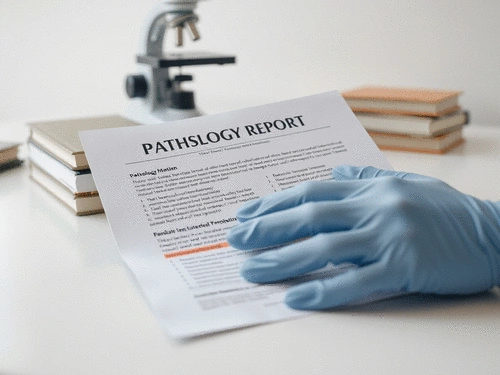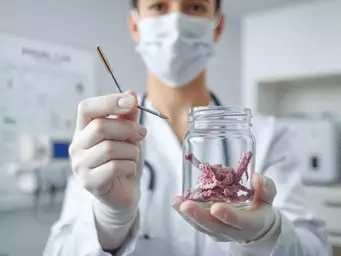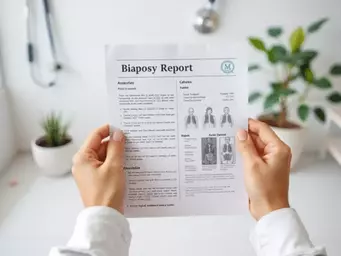Understanding your pathology report can feel daunting, but it doesn't have to be. Empower yourself by learning how to read and interpret the key sections of your report—this knowledge can significantly enhance your conversations with healthcare providers and help you make informed decisions about your health.
What You Will Learn
- The importance of specimen information in understanding your diagnosis.
- Key terms like benign and malignant that are crucial for assessing your health status.
- How microscopic and gross descriptions inform treatment planning.
- The role of the synoptic summary in distilling the essential findings from your report.
Interpreting Your Pathology Report: A Section-by-Section Guide
Understanding your pathology report is crucial for navigating your health journey. Here’s a breakdown of its key sections to empower you in discussions with your healthcare team.
Specimen Information
Details the type of tissue collected (e.g., needle, surgical, skin biopsy) and the collection method. Crucial for diagnosis context.
- Identifies tissue type
- Clarifies collection method
Diagnosis
The core finding: determines if growths are benign (non-cancerous) or malignant (cancerous), guiding treatment.
- Benign: Non-cancerous
- Malignant: Cancerous
- Specific cancer types
Microscopic & Gross Descriptions
Detailed characteristics of the tissue, both visually (gross) and at a cellular level (microscopic).
- Microscopic: Cellular structure
- Gross: Size, shape, color
Synoptic Summary
A concise overview of the most critical findings, summarizing diagnosis and treatment implications.
- Highlights significant findings
- Summarizes treatment implications
Understanding Your Pathology Report: An Essential Guide
After a biopsy, receiving your pathology report can feel overwhelming. But understanding this report is crucial for your healthcare journey. It's not just a series of medical terms; it reflects your health status and guides treatment decisions, especially in the context of potential cancer diagnoses. By grasping the details within your report, you become empowered to engage in meaningful conversations with your healthcare providers. For more detailed information on what's typically included, you can consult resources like the American Cancer Society's guide to understanding pathology reports.
Not only does understanding your report help reduce anxiety, but it also equips you to make informed choices. Remember, knowledge is a powerful tool in your health journey!
Why Knowing How to Read Your Report Matters
Let’s face it—medical jargon can be intimidating, especially when it concerns something as serious as a biopsy. That's why I’m here to help you navigate through your pathology report. Knowing how to interpret the information can significantly enhance your understanding and comfort level.
- It helps you recognize key findings that could impact your treatment.
- Understanding your report facilitates better communication with your healthcare team.
- It allows you to take an active role in your health decisions.
When you feel informed, you’re not just a passive patient; you’re an advocate for your own health. This kind of engagement is vital, especially when dealing with conditions that may require ongoing treatment or monitoring.

Breaking Down the Pathology Report Sections
Specimen Information: What You Need to Know
The first section of your pathology report will include specimen information, detailing the type of sample collected. This could include a needle biopsy, surgical sample, or skin biopsy. Understanding this section is vital because it sets the stage for the diagnosis.
- Identifies the type of tissue sampled.
- Clarifies the collection method used.
- Can indicate the stage of disease, if applicable.
This information influences how your doctor interprets the results and plans your treatment. If you're unsure about any terms, don't hesitate to reach out for clarification! Remember, the more you know, the more confident you will feel.
Deciphering the Diagnosis: Key Terms Explained
Next, we dive into the heart of the report—the diagnosis itself. In this section, you’ll see terms like benign, malignant, and various cancer types. Understanding these terms is crucial in assessing what lies ahead.
- Benign: Non-cancerous growths that typically do not pose a risk to your health.
- Malignant: Cancerous growths that can invade nearby tissues and spread to other parts of the body.
- Specific cancer types: Information that helps define the nature of the tumor and guides treatment options.
Having clarity on diagnosis terms not only eases your mind but also prepares you for discussions about potential treatment options. This is an important part of your healthcare journey!
Microscopic and Gross Descriptions: Understanding the Details
Your pathology report will also include microscopic and gross descriptions. These sections provide insight into the characteristics of the tissue samples under examination.
- Microscopic description: Information about cellular structure and patterns observed through a microscope.
- Gross description: Visual examination details of the specimen, including size, shape, and color.
Both descriptions are vital for understanding tumor characteristics. They give your doctor critical insights that can affect treatment planning. For further details on reporting standards, resources like the College of American Pathologists (CAP) guidelines offer comprehensive information. If you have any questions about what these descriptions mean, feel free to ask your healthcare provider!
The Synoptic Summary: A Quick Glance at Key Findings
Finally, your report will likely feature a synoptic summary, which condenses the most critical findings into a few sentences. This summary is beneficial because it enables you to quickly grasp the main points of your diagnosis. Standardized reporting, as outlined in resources like the SEER Program's manual, helps ensure consistency and clarity in these summaries.
- Highlights significant findings from the pathology report.
- Summarizes implications for treatment.
- Can offer a straightforward overview of tumor characteristics.
Interpreting this summary can help you prepare for what comes next, allowing you to engage fully in conversations about your healthcare options.
Frequently Asked Questions About Your Pathology Report
Q1: What is a pathology report?
A pathology report is a medical document generated after a biopsy or surgical removal of tissue. It contains detailed information about the tissue sample, including its characteristics and diagnosis, which helps guide treatment decisions.
Q2: Why is it important to understand my pathology report?
Understanding your pathology report empowers you to engage in informed discussions with your healthcare providers, reduces anxiety, and helps you make active decisions about your health journey and treatment options.
Q3: What does "benign" mean in a pathology report?
"Benign" indicates that a growth or tumor is non-cancerous. These growths typically do not spread to other parts of the body and are generally not life-threatening.
Q4: What does "malignant" mean in a pathology report?
"Malignant" indicates that a growth or tumor is cancerous. Malignant cells have the potential to invade surrounding tissues and spread to other parts of the body through a process called metastasis.
Q5: What is the difference between microscopic and gross descriptions?
The gross description details the visual characteristics of the tissue sample as seen with the naked eye (e.g., size, shape, color). The microscopic description provides information about the cellular structure and patterns observed when the tissue is examined under a microscope.
Q6: What is a synoptic summary?
A synoptic summary is a concise overview within the pathology report that condenses the most critical findings and their implications for diagnosis and treatment. It provides a quick glance at the essential information.
Interactive Poll: Your Thoughts
As you reflect on your pathology report, we want to know: What aspect of your report do you find most challenging to understand?
Summarizing Key Takeaways from Your Pathology Report
Understanding your pathology report is crucial for navigating your health journey. It provides insights not just into what was found during your biopsy, but also how those findings affect your treatment options. Here are the key points to keep in mind:
- Specimen Information: Know what type of sample was taken and how it plays a role in your diagnosis.
- Diagnosis: Familiarize yourself with the terms like benign or malignant, which are fundamental for understanding your results.
- Microscopic Details: These descriptions offer insight into the characteristics of any tumors present and their behavior.
- Synoptic Summary: This section gives a quick overview of the essential findings, which can guide your next steps.
By synthesizing this information, you can approach conversations with your healthcare team more confidently. It’s about empowering yourself with knowledge, which I believe is a vital aspect of patient care at What Is A Biopsy.

Taking Control: Your Next Steps Towards Health
Once you’ve reviewed your pathology report, it’s time to take action! Engaging with your healthcare providers is an important step in advocating for your health. Here are a few ways to get started:
- Ask Questions: Prepare a list of questions based on your report so you can have a productive discussion with your doctor.
- Explore Treatment Options: Don’t hesitate to discuss the potential pathways for your condition—knowledge is power!
- Express Concerns: Share any worries you have about your diagnosis or treatment. Your feelings are valid, and understanding them can help your provider support you better.
Remember, advocating for your health means being informed and proactive. I encourage you to keep the lines of communication open with your medical team. The more you understand your pathology report, the clearer your path forward will be.
Additional Resources for Patients
At What Is A Biopsy, we strive to provide you with the tools and knowledge necessary to make informed decisions about your health. Here are some resources you can explore:
- Glossary of Pathology Terms - A handy reference guide to familiarize yourself with common terms.
- Interactive Tools - Engage with visual aids that simplify complex topics related to your biopsy.
- Further Reading - Articles that delve deeper into specific types of biopsies and their implications.
Utilizing these resources can help you gain a better understanding of your pathology report and what it means for your health. Empower yourself to ask the right questions during your medical appointments!
Enhancing Your Health Literacy: Tools for Understanding Medical Terminology
Improving your health literacy is essential for effective communication with your healthcare providers. Here are some strategies to enhance your understanding of medical terminology:
- Utilize Reliable Websites: Resources like What Is A Biopsy provide trustworthy information regarding biopsy procedures and related topics.
- Attend Workshops or Webinars: Many organizations offer educational sessions that can help demystify medical jargon.
- Leverage Apps: Consider downloading health literacy apps that can assist you in understanding complex medical terms.
By taking these steps, you can improve your health literacy and feel more confident discussing your diagnosis and treatment with your healthcare team. Remember, it’s all about taking charge of your health journey!
Recap of Key Points
Here is a quick recap of the important points discussed in the article:
- Understanding Your Report: Knowledge of your pathology report empowers you to engage effectively with your healthcare team.
- Specimen Information: Familiarize yourself with the type of sample collected, as it is crucial for diagnosis.
- Diagnosis Terminology: Understand key terms like benign and malignant to assess your health status accurately.
- Microscopic and Gross Descriptions: These sections provide vital insights into tumor characteristics that can influence treatment plans.
- Synoptic Summary: This quick overview highlights the most significant findings and implications for your care.









